The New Horizons space probe, launched on January 19, 2006, was designed to fly by Pluto and to study that body and its satellites. On July 14, 2015, after a 9½-year journey, New Horizons reached the vicinity of Pluto, flying only 12,500 km (7800 mi) above the surface of that body at 7:49 AM EDT. At that time, Pluto was 31.9 astronomical units (au) from Earth, or about 4.8 × 109 km (3.0 × 109 mi), and signals from New Horizons, travelling at the speed of light, took 4 hours 25 minutes to reach Earth. See also: Pluto; Space probe
Pluto was the last of the “classical” nine planets to be explored close-up by a spacecraft. Seven months after New Horizons was launched, Pluto’s status was “demoted” to that of a “dwarf planet,” a new category of objects that was created by the International Astronomical Union after the discovery of a more distant body, Eris, whose diameter was approximately the same as that of Pluto, and which was found to be about 27 percent more massive. Pluto and Eris are now seen to be the largest known bodies in a family of many thousands of objects just beyond the orbit of the planet Neptune that is termed the Kuiper Belt. However, some astronomers disagree with the relabeling decision and have suggested alternative classifications in which both Pluto and Eris are treated as planets. See also: Kuiper Belt; Large Kuiper Belt objects; Planet
Long thought to be an isolated body after its discovery in 1930, in 1978 Pluto was found to have a satellite, Charon, which is unique in the solar system in having a diameter about half that of Pluto itself. In addition, four smaller satellites of Pluto were discovered with the Hubble Space Telescope between 2005 and 2012. See also: Hubble Space Telescope
The New Horizons flyby of Pluto marked the end of an era of planetary exploration that began with the Mariner 2 flyby of Venus in 1962, since it will probably be some decades before space probes are sent to Eris or other large Kuiper Belt objects. But in many ways, the discoveries of New Horizons are turning out to be more dramatic than those of any of its predecessors. Pluto’s diameter is only about two-thirds that of Earth’s Moon. Because of its small size and its great distance from the Sun, Pluto was long thought to be a rather uninteresting “dead” world, but the New Horizons observations are telling a very different story, as they reveal evidence of widespread geological activity and unexpected meteorological phenomena, such as the formation of mountain ranges of water ice, nitrogen ice flowing glacier-like across the surface, an unexpectedly low surface atmospheric pressure, and haze layers at altitudes higher than had been thought possible.
As New Horizons approached Pluto it was already providing important results. A chain of dark Missouri-sized spots on Pluto was first seen on July 2, and by July 11 a dark spot marking Charon’s north polar region was visible. On July 13, Pluto’s diameter was measured to be 2370 ± 20 km (1473 ± 12 mi), making it slightly larger than Eris. An image of Pluto (below) from a distance of 450,000 km (280,000 mi) shows a bright heart-shaped region that was named Tombaugh Regio in honor of Clyde Tombaugh, Pluto’s discoverer.
Adjacent to Tombaugh Regio are dark regions that are believed to be coated with hydrocarbons. At the upper edge of the dark region to the left of Tombaugh Regio (see the image below) is a feature that appears to be a crater punched through the hydrocarbon layer, excavating the ice below. The hydrocarbon coating is thought to be generated in a process that begins when methane ice on Pluto’s surface is warmed and turns to gas, entering the atmosphere. Bombardment by solar ultraviolet radiation breaks down the methane molecules, triggering the buildup of more complex hydrocarbon molecules such as ethylene and acetylene, which were observed at Pluto by New Horizons. As these hydrocarbons fall to lower, colder parts of the atmosphere, they condense as particles, forming hazes. Solar ultraviolet radiation converts these hazes into dark, reddish hydrocarbon substances known as tholins. The tholin particles grow in size until they fall to the ground, producing the dark regions and also giving the entire body a reddish color. See also: Acetylene; Ethylene; Methane
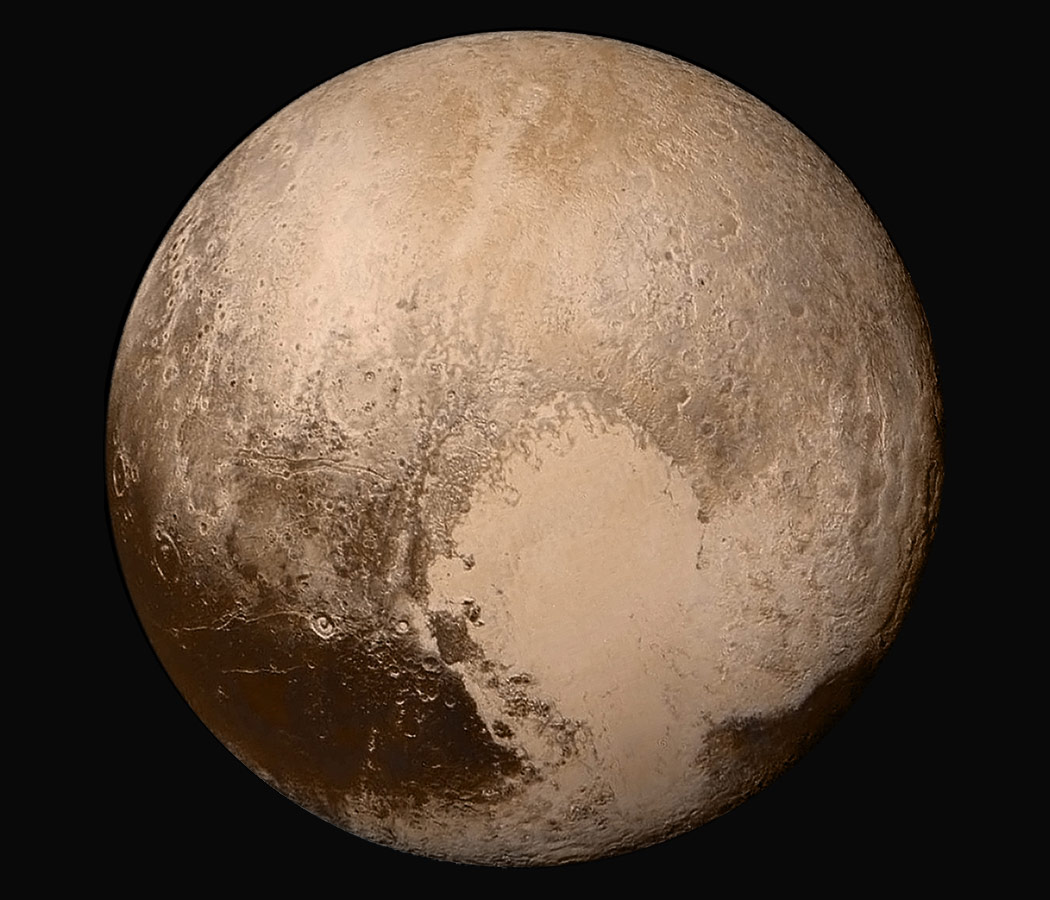
False-color images of Pluto (below) and Charon were created with a Ralph instrument, which uses several filters to isolate certain wavelengths of light. They highlight the differences of the various terrains in surface texture and composition. The central lobe of Tombaugh Regio, informally named Sputnik Planum, is seen to be a pinkish color, while the lobes extending to the northeast and southwest are bluish white, indicating different compositions. Further analysis indicates that Sputnik Planum is coated in nitrogen, methane, and carbon monoxide ices, with concentrations of carbon monoxide in the central portion higher than anywhere else on Pluto. See also: Astronomical spectroscopy
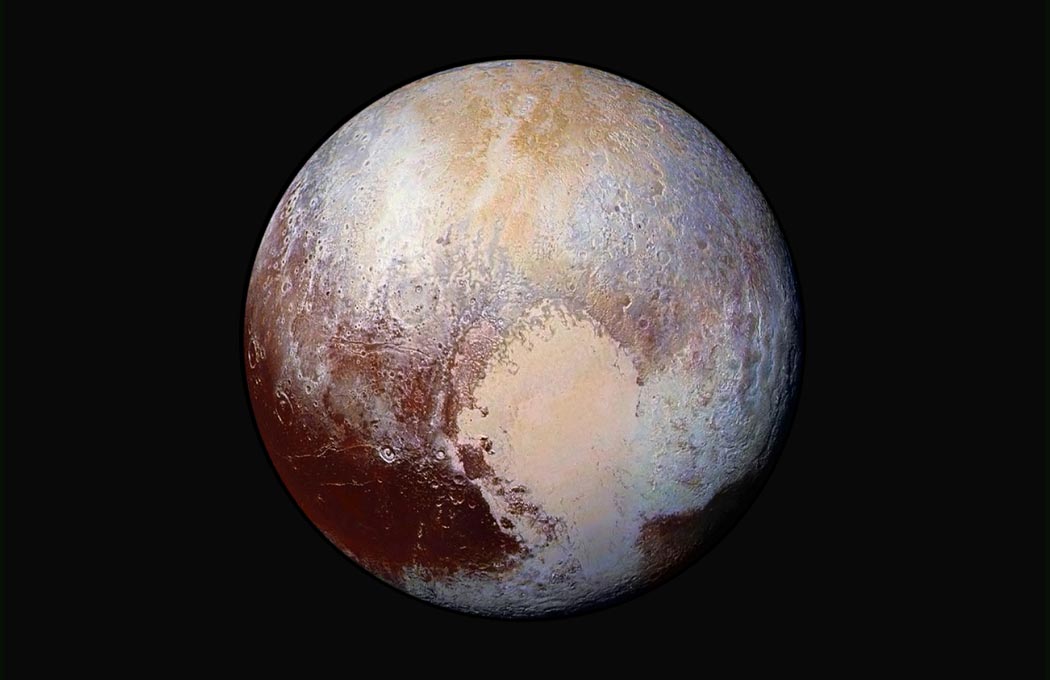
In the false-color image of Charon (not shown here), the dark spot in the north polar region is the same color as the dark regions on Pluto, supporting the hypothesis that Charon’s dark pole consists of material carried from Pluto. As Pluto’s atmosphere escapes, some of it lands on Charon. Most of the surface is too warm for the fleeing particles to stick, but the pole might be cold enough to grab them and hold on. However, this scenario needs to be supported by the analysis of more data from the spacecraft.
During the flyby, the spacecraft sent no messages for a 22-hour period since it was completely occupied with making observations. When transmissions resumed, data were sent from the part of the mission when the spacecraft was closest to Pluto and Charon, and the results were extraordinary. An image of an area about 240 × 240 km (150 × 150 mi), near the bottom of Tombaugh Regio in the above images, showed a range of ice mountains (below) some 3400 m (11,000 ft) high, comparable to the Rocky Mountains. They are informally named Norgay Montes, after Tenzing Norgay, one of the first two climbers to reach the summit of Mount Everest in 1953. Nitrogen, methane, and carbon monoxide ices would be much too soft to support mountains of this size, and they were therefore deduced to be composed of water ice, which would be rock hard at Pluto’s temperature of about 38 K (−235°C or −391°F). This image was also notable for its lack of a single impact crater, in spite of the constant bombardment of the surface of Pluto by small Kuiper Belt objects. This indicates that surface features must have been erased by erosion or tectonic activity in the geologically recent past, that is, within the past 100 million years, and that the mountains must have formed during this time. See also: Meteorite; Plate tectonics
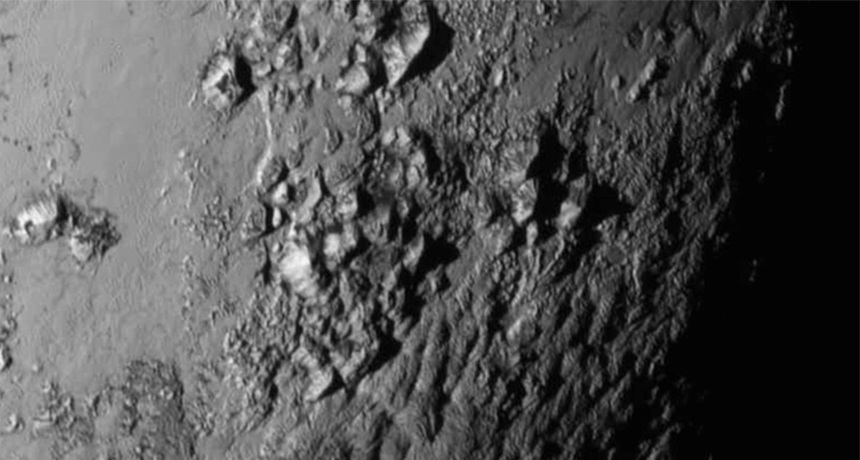
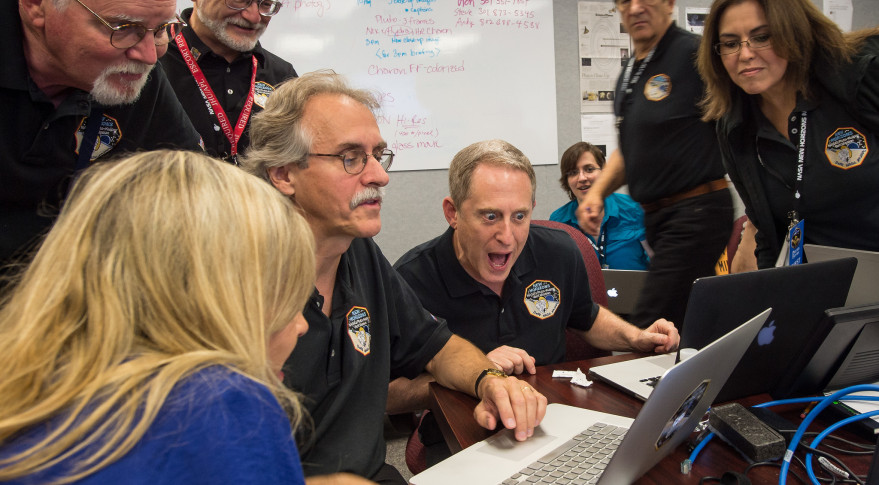
Thus, at least in this region of Pluto, there must have been recent geological activity. Such activity has been observed in satellites of the giant planets, where it is believed to arise from heat generated by tidal forces, but such forces are small on Pluto. Thus, the source of the activity in this small body is a mystery at present. Possible causes include radioactive decay, an internal ocean, or energy stored during Pluto’s formation.
An image of a portion of Sputnik Planum (below), not far from Norgay Montes, showed a flat plain, again notable for its lack of craters, indicating that it is also less than 100 million years old, in contrast to the dark, cratered region adjacent to Tombaugh Regio, which must date back billions of years. Shallow troughs divide Sputnik Planum into polygonal regions, roughly 20–30 km (12–20 mi) across. The origin of these troughs has not been determined. They might be signs of convection, caused by heat within Pluto, or they might be cracks caused by surface contraction. Within the troughs are dark areas, which may be irradiated hydrocarbons, and clusters of hills of unknown origin. See also: Convection (heat)
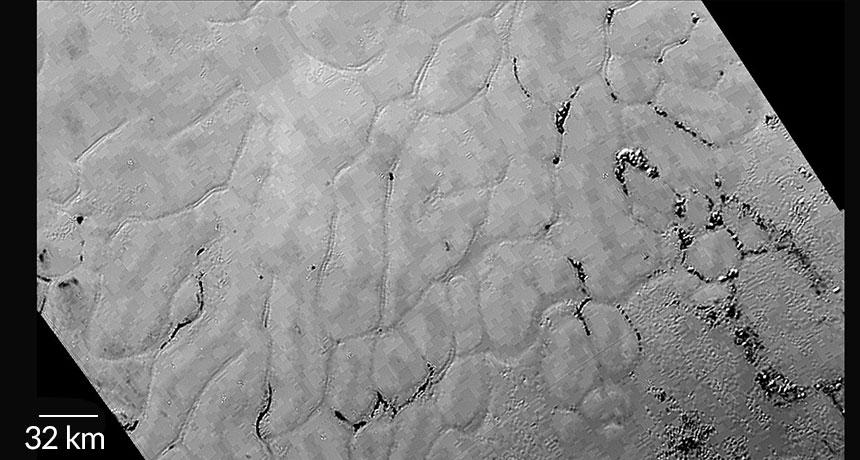
A second range of water-ice mountains (below), informally named Hillary Montes for Sir Edmund Hillary, who was Norgay’s climbing partner, was discovered 110 km (68 mi) northwest of Norgay Montes, between Sputnik Planum and the dark terrain adjacent to it. It is estimated to be 1600 m (5200 ft) high, comparable to the Appalachian Mountains. In the image below, the bright sediment-like material from Sputnik Planum appears to be filling in old craters (for example, the bright circular region to the left of center).
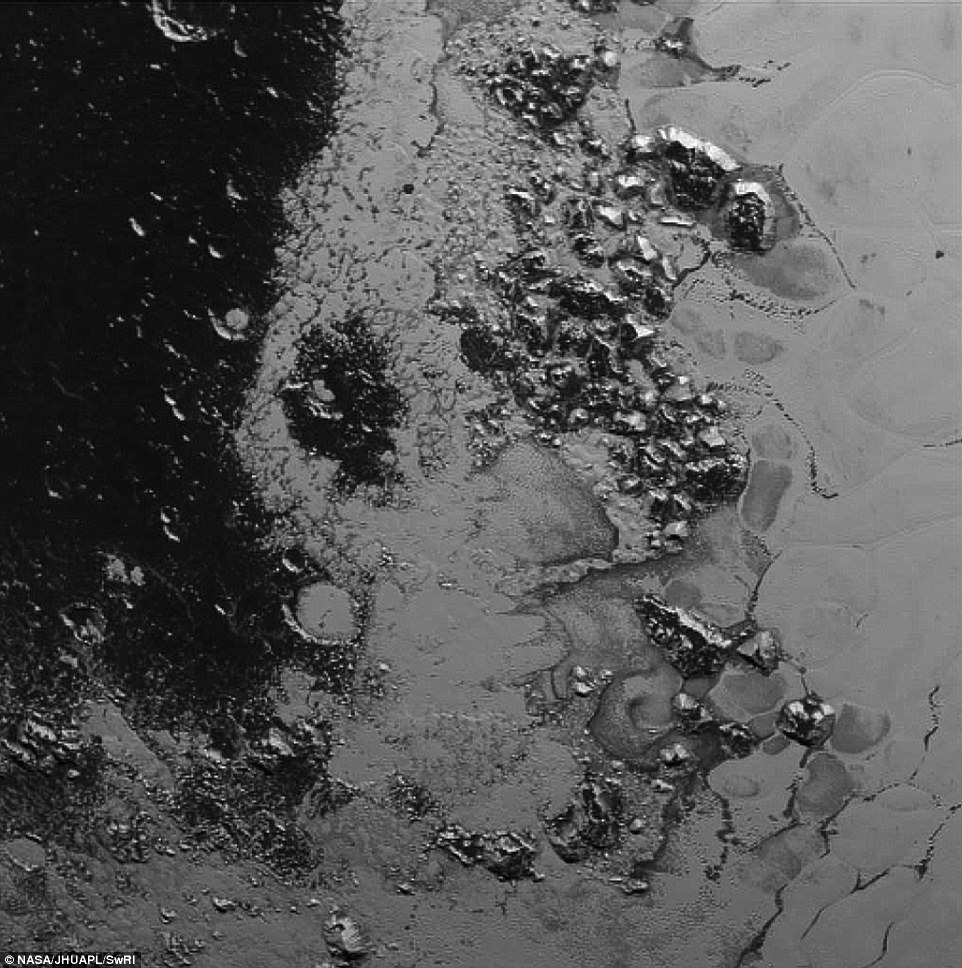
In an image from the northern region of Sputnik Planum (below), swirl-shaped patterns of light and dark suggest that a surface layer of exotic ices, primarily frozen nitrogen, is moving and spreading, flowing around obstacles and into depressions such as craters, comparable to the flow of water ice in glaciers on Earth. Indeed, evidence of this type of geological activity has been observed previously only on Earth and Mars. See also: Glaciology
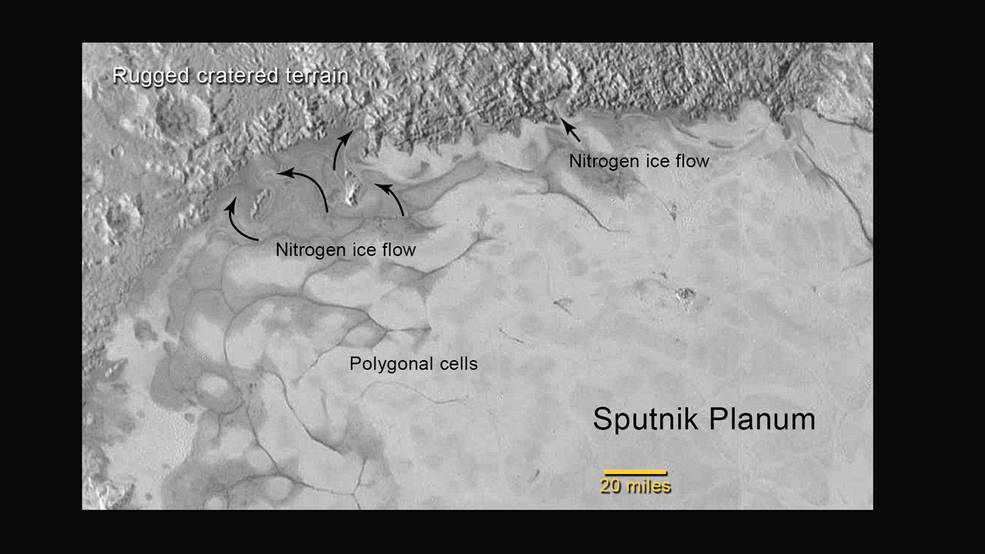
Images of Charon (below) were remarkable as well, revealing a complex terrain, including regions with relatively few craters and a swath of troughs and cliffs about 1000 km (600 mi) across, both indicative of geological activity. There is also a canyon 7–9 km (4–6 mi) deep, surprising on a body only 1207 km (750 mi) in diameter, and a depression with a peak in the middle, which has been described as a “mountain in a moat,” whose origin, again, is a mystery. The dark region near the north pole was seen in more detail, including small, bright craters that suggest that the dark-coated material is a thin layer on top of other ices.
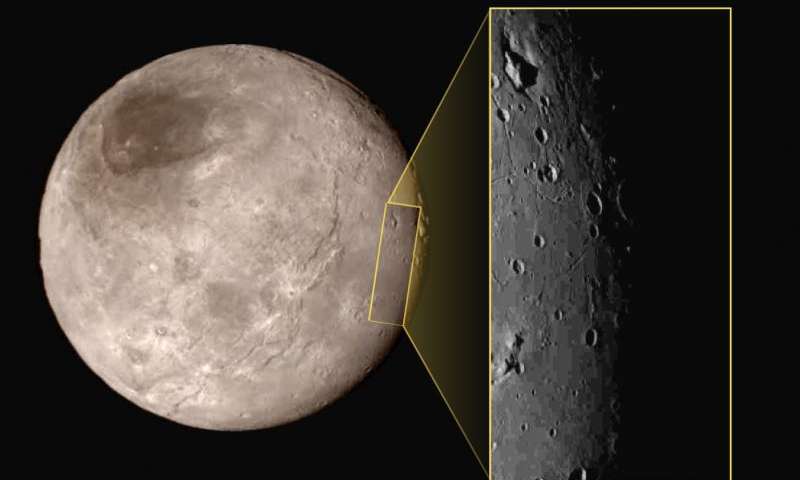
New Horizons also obtained images of the small satellites Nix and Hydra (below). Nix is jelly-bean shaped, around 42 km (26 mi) long and 36 km (22 mi) wide. The reddish area on Nix in the image below may be a crater, but more data will be needed to determine its nature. Hydra is irregularly shaped, around 55 km (34 mi) long and 40 km (25 mi) wide, with what appear to be two large craters and some variation in surface composition.
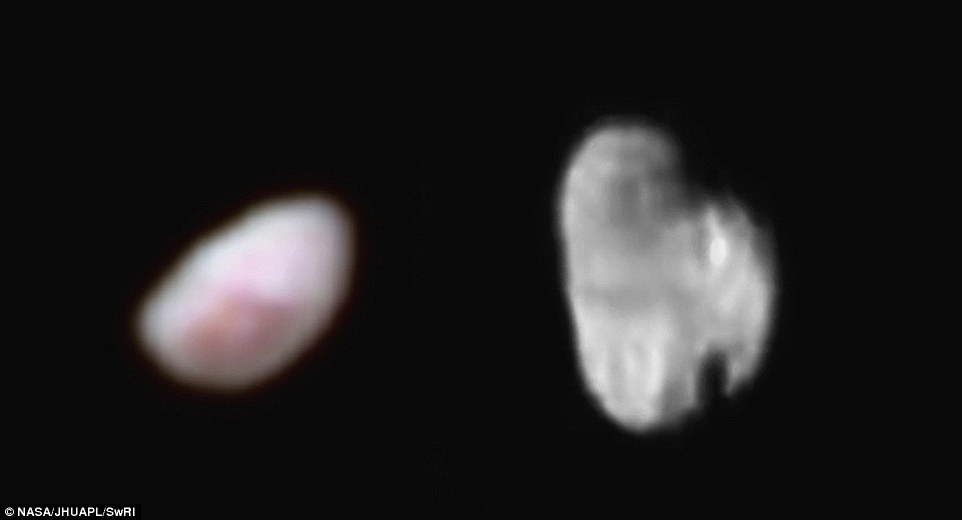
New Horizons observed a plasma tail of nitrogen ions that extends tens of thousands of kilometers from Pluto in the direction away from the Sun, much like a comet’s tail. It is formed from nitrogen molecules that are ionized by solar ultraviolet radiation as they escape Pluto’s atmosphere and are carried away by the solar wind. See also: Comet
Pluto reached perihelion in 1989, and since has been moving away from the Sun on its elliptical orbit. Eventually, the atmosphere is expected to cool to the point that it will freeze on the surface. However, observations of stellar occultations by Pluto indicated that in 2002 the surface atmospheric pressure was twice as high as it was in 1988, near perihelion, and that the atmosphere had warmed somewhat, suggesting that Pluto experiences temperature lags, as does Earth. But the New Horizons Radio Science Experiment (REX), which measured the refraction of radio waves beamed from Earth to the spacecraft as it passed behind Pluto about an hour after its closest approach, indicated that the surface atmospheric pressure at Pluto was only about half that expected from previous Earth-based observations, suggesting that half of Pluto’s atmosphere has recently frozen onto the surface. See also: Occultation
As New Horizons sped away from Pluto, it took an image (below) from within Pluto’s shadow in which Pluto’s atmosphere is backlit by the Sun, ringing Pluto’s silhouette like a luminous halo. The image revealed haze extending up to 160 km (100 mi) from the surface, with two distinct layers at altitudes of 50 and 80 km (30 and 50 mi). Since scientists had previously calculated that temperatures would be too warm for particles to condense from the atmosphere to form haze at altitudes greater than about 30 km (20 mi), the existence of haze at these greater altitudes is another mystery that remains to be resolved.

The final long-range image of Pluto was scheduled to be taken July 30, when the spacecraft would have accumulated about 50 gigabits of data. Because of the spacecraft’s great distance from Earth and the modest power of the transmitter/antenna system (12 W), it will take 16 months to transmit this data, and of course the analysis, interpretation, and understanding of this information will take much longer. Meanwhile, New Horizons will be targeted to fly by a small object farther out in the Kuiper Belt to make observations of it as well. See also: New Horizons: second destination





